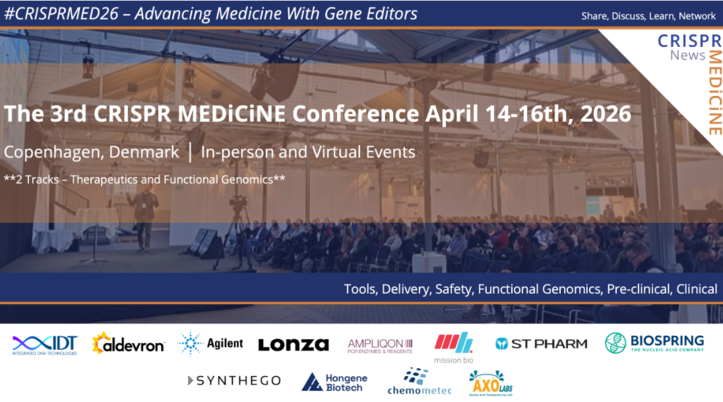A Decade of CRISPR and a Promising Future - Exclusive Insights from Brad Ringeisen, Innovative Genomics Institute

(Interview is condensed and edited for clarity)
Hi Brad, it's great to speak with you again and I’m excited to hear your perspectives on CRISPR - past and future. In your opinion, what has been the biggest success within CRISPR so far?
I’m very excited about the major advances within medicine. It’s only been 10 years since the seminal CRISPR publications in Science and PNAS, and in this time, we've gone from essentially a demonstration of genome editing in a test tube all the way to real-world cures.
Multiple clinical trials are advancing, and these are showing us that people are tolerating gene-editing treatments for haemoglobinopathies such as sickle cell and beta thalassemia, cancers and several rare genetic diseases. To see that CRISPR is working across multiple diseases with therapies developed by different groups around the world is truly remarkable.
CRISPR therapy in future
Where do you see CRISPR therapy heading in the next decade?
Most of the clinical successes to date have been with ex vivo CRISPR-edited cell therapies. While it’s possible to perform exquisite edits ex vivo, the approach is tedious, time-consuming and editing efficiency can be an issue. Patients also have to undergo conditioning or cell-ablative chemotherapy to make way for and tolerate the edited cells, which is again time-consuming and expensive and comes with an additional set of risks.
We at IGI are very focused on affordability and accessibility of gene-editing therapies and I think that in vivo treatments are a big part of the solution. Intellia Therapeutics is succeeding in treating transthyretin amyloidosis with in vivo CRISPR therapy targeting the liver, which is probably the easiest organ to target. This is the only clinical example of systemic in vivo CRISPR therapy so far. We need to get better at targeting other organs and move towards more in vivo therapies. I think this will make the biggest impact across the world and should have top priority for the next decade.
Many of the current programmes are targeting a handful of genetic diseases. Do you think this trend will change over the next decade?
I think we will see much more epigenetic editing, using CRISPRa to activate genes and CRISPRoff to turn off genes. I believe that this will be the key that unlocks cures to common and complex diseases such as cancer and neurodegenerative diseases. Wouldn’t it be great if we could go into an individual’s genome and systemically control gene expression, rather than clipping genes and permanently turning off their expression? We may not fully realise this in 10 years, but I think we will be in a very different place with epigenetic editing in five to 10 years than where we are today. There is also a chance to develop platform CRISPR technologies that enable much more rapid development of cures for a number of unique, rare, or neglected diseases. Ultimately the goal will be to treat as many people as possible with the most accessible and affordable therapies.
The challenges with CRISPR therapy
Given what has happened within medicine so far, it looks like we're seeing the tip of the iceberg regarding what is possible. What challenges have we seen during the past decade?
Five or six years ago, there really were no safety bumpers on CRISPR technology. There wasn't an off switch, and off-target effects were a significant problem. During my time at DARPA, a former colleague Dr. Renee Wegrzyn, who is now at Ginkgo Bioworks, started a programme called Safe Genes, to implement some safety bumpers. The programme resulted in small molecule and protein blockers that provide better control over Cas-mediated gene-editing reactions, which I think was an important step forward.
We’ve come far since then with more precise editors available as well as newer editing modalities, such as base editing, that don’t require double-strand breaks, and methods to control gene expression, but I believe that improving delivery and targeting are still the biggest opportunity space.
The gene-editing community is getting better at finding off-targets. Do you think it will become more or less difficult to advance CRISPR programmes to the clinic in future, and are the current analysis tools enough to get clinical-stage CRISPR therapies over the approval line?
This is a fantastic question and I would say yes. It has been demonstrated across multiple different companies, clinical trials and academic labs that CRISPR is safe and effective. On the other hand, we have also seen clinical trials halted or paused because of safety concerns, so the clinical path is unlikely to be smooth every time.
Overall, we are moving in the right direction. For instance, the National Institute for Standards and Technology has started a rigorous standardisation process for gene editing. This will be an extremely important resource for the CRISPR community going forward.
As a side comment to safety, we [IGI] see companion diagnostics as an extremely valuable tool to supplement clinical trials and ensure that the right patients receive the right therapies, for instance, based on their exact mutations, and so that we can accurately monitor the efficacy of a therapy. We recently got funding through the California Institute of Regenerative Medicine to develop companion diagnostics, and we’re already developing this alongside a sickle cell disease trial run by Professor Mark Walters at the University of California San Francisco that is using an IGI-developed treatment.
Applying CRISPR to major world problems
CRISPR therapy has been the major focus for the past decade. I’ve read that part of the IGI’s future mission is to use CRISPR to tackle some major problems within climate and agriculture. How has this come about?
Shortly after I became the IGI’s Executive Director in 2020, Jennifer Doudna and myself sat down to discuss other enormous challenges and problems in society right now given that CRISPR medicine has really taken off. And we both almost simultaneously said, climate and food security, how are we going to feed 10 billion people in less than 30 years?
And how can CRISPR solve these problems?
Agriculture is responsible for at least a quarter of all greenhouse gas emissions. If we go from 7 billion people to 10 billion people, you can imagine that number will be much larger than 25%. So we have to change the way that we're doing agriculture, and CRISPR is a part of that solution.
Can you give me couple of concrete examples?
I’ll give you two examples. The first is about trying to revolutionise the way we do farming. I think that CRISPR has the ability to potentially create a net zero farm. For instance, we could use CRISPR to reduce farmer inputs, such as the need for irrigation by making crops able to grow with less water, and to reduce pesticide use by making crops resistant to some of the major pathogens and pests.
It should also be possible to reduce the emissions that are involved in agriculture, which are primarily methane and nitrous oxide. I think we can go in with CRISPR and modulate the expression of the genes that are responsible for methane production, which typically comes from livestock emissions and cultivating rice. We might also be able to tweak some of the pathways that feed the methane-producing microbes.
The second example is carbon dioxide removal or CDR which is a very popular concept right now. There are some engineered systems that remove CO2 from the atmosphere using massive fans and catalysts or other approaches that capture carbon from biomass for long-term underground storage. I think CRISPR can offer a solution here by increasing the efficiency of photosynthesis in plants on natural lands, and/or agricultural crops, which will increase the carbon capture from the atmosphere. But of course, if you just increase photosynthesis, you’ll increase the biomass, but if you don't also tune and tweak the microbes in the soil around those plants, they may just digest that biomass and release it back into the atmosphere as greenhouse gases. We’re trying to approach this in a holistic way, by looking at the capture of the carbon and where that carbon goes. And we can potentially use CRISPR to control where it goes and to convert it into stable forms in the soil or as biomass that could potentially be used for CDR.
CRISPR and climate so far
These sound like fascinating opportunities. Where are we with these approaches?
It’s early days yet, but the Salk Institute at UC San Diego received a substantial grant in 2019 to combat climate change through the Harnessing Plants Initiative. Joanne Chory at Salk is leading this initiative and one of the major projects addresses CDR. They’re trying to use suberin, a natural biopolymer found in cork, to create a very stable underground biomass that can last for tens to hundreds of years, as a way to store some of the carbon that's soaked up by photosynthesis.
What, if any, major gaps in our understanding need to be filled before we can fully realise the CRISPR approaches to farming and CDR?
Firstly, the plant/microbial world is tremendously complicated and it really is like the last frontier. One single cubic centimeter of soil can contain up to a billion microbes. If you think about carbon flowing into that system, it becomes very complex, with so many different microbes that have many different metabolic features. It's difficult to engineer that system, if you shut off one, there's most likely going to be another one that pops out. That’s the true challenge with the microbial world.
When it comes to plants, the advances have been incredible. We can already make plants that express gene-editing molecules with tissue specificity, which helps limit off-target effects and increases the efficiency of editing. The problems we need to fix, however, occur in complex, multidimensional systems. We have people working on suberin, but we also need groups working on photosynthesis to capture more carbon, as well as other biopolymers that might be recalcitrant to breakdown by soil microbes. And then we need people to look at the soil microbiome to try to put more carbon back into the soil and keep it there. All these things need to be done for true CDR, and I think that CRISPR approaches in plants and microbes are a substantially promising part of the solution.
What about safety and off-targets when it comes to plants? Is it less important to be concerned about these as long as we see the desired phenotypes?
It’s a great question and the immediate answer is that you always need to worry about off-target effects! People tend to become sensitive about putting CRISPR-modified cells or CRISPR reagents directly into the body, and for good reason. Although often gene-edited food products [plants with gene knockouts] are not considered genetically-modified organisms, at least not in the US, the more accuracy we can achieve the better especially when it comes to regulatory bodies.
For some of the climate approaches I talked about earlier, I think it would actually matter a little bit less, for instance if we are only affecting a cover crop that is not going to be ingested by humans. Likewise, there could be opportunities to engineer deeper or more recalcitrant roots that won’t be ingested by livestock or humans.

Synergistic community approaches needed
Looking ahead, on a practical level, how easy will it be to achieve impactful synergy between CRISPR scientists and farmers?
It’s not easy to apply innovative science to field applications rapidly but that’s what we have to do in agriculture, and soon. Richard Swett and Michael Rowan of Climate Prosperity Enterprise Solutions (CPES) have an outside-the-box application developing in African nations that is promising. They are proposing to build Sustainable Solar Communities in rural Africa – Malawi, Cape Verde, Nigeria, Sudan and Madagascar are interested -- which could house the laboratories connecting CRISPR scientists to Africa’s great but unrealised agricultural potential.
These solar communities will attract top digital firms in agriculture, energy and IT to establish smart farms which minimise land and water use, and avoid pests, pesticide use and carbon emissions, while producing nutritious foods in the very places where the World Food Program is feeding the hungry and where African farmers need jobs. This is a perfect environment for a CRISPR lab.
IGI and CPES will work with African universities, microbiologists and farmers to create the labs that advance the local capacity to attain food security while reducing the desertification, deforestation, soil erosion and degradation challenges facing the continent. It’s an ambitious but doable vision. And the world community will hear about it: The CPES community project platform transparently reports the inputs and outcomes of community farming applications online so farmers can learn from them. Through partnerships like these in Africa, CRISPR can have a powerful impact on agriculture. A lot of work needs to be done but we’re optimistic.
Video description: Proposed plans to build a sustainable solar community in Malawi, rural Africa. Video credit: Climate Prosperity Enterprise Solutions.
Where do you think we’ll be with CRISPR and sustainable agriculture 10 years from now?
I think the sky's the limit. I think we are guaranteed to see widespread drought-tolerant crops. We’re working on a water-retaining rice crop right now, and we’re looking at 7–10-year timelines from lab to field trials and then to potentially international field trials. I think similar things can be done with wheat and maize. I also think that some pathogen- and pest-resistant crops will emerge. Such crops have commercial markets, so they’re going to happen.
Whether we’re going to see enormous successes on the climate side is less certain. There isn’t really a commercial market for plant and soil CDR unless it becomes possible to quantify the amount of carbon that is prevented from entering the atmosphere. There's also no commercial market for reducing methane from cows or rice unless you can see an increase in productivity or efficiency of the farming. So we're at a crossroads with respect to CRISPR and climate and we’ll need to see a lot of funding in many different areas with synergistic community approaches before really big advances start to happen.
Relevant links:
- Jinek M. et al. 2012. A programmable dual-RNA-guided DNA endonuclease in adaptive bacterial immunity. Science, 337(6096):816-21. doi: 10.1126/science.1225829
- Gasiunas G. et al. 2012. Cas9–crRNA ribonucleoprotein complex mediates specific DNA cleavage for adaptive immunity in bacteria. PNAS, 109 (39) E2579-E2586; https://doi.org/10.1073/pnas.1208507109.
- In the present interview, Brad Ringeisen refers to a clinical trial run by Professor Mark Walters at the University of California San Francisco that is using an IGI-developed treatment. You will find a link to this trial here.
- Climate Prosperity Enterprise Solutions website.
CRISPR Medicine News follows all the clinical trials for gene-editing therapies. You will find a complete overview of current gene-editing clinical therapeutic trials as well as diagnostic trials, check out CRISPR Medicine News' Clinical Trials Database.
To get more of the CRISPR Medicine News delivered to your inbox, sign up to the free weekly CMN Newsletter here.
Tags
A decade of CRISPRArticleInsightInterviewNewsCARBONClinical News UpdatesSickle Cell Disease, SCDBase editorsCRISPR-CasCRISPRaCRISPRiNational Institute of Standards and Technology (NIST)StandardsSafety
CLINICAL TRIALS
Sponsors:
Suzhou Maximum Bio-tech Co., Ltd.
Sponsors:
Zhejiang University








